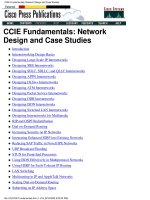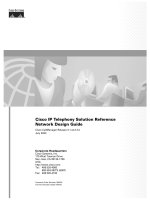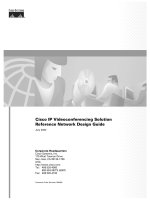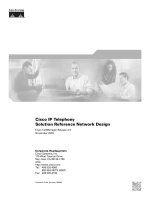Neuron network design
Bạn đang xem bản rút gọn của tài liệu. Xem và tải ngay bản đầy đủ của tài liệu tại đây (11.27 MB, 1,012 trang )
Neural
Network
Design
2nd Edition
Hagan
Demuth
Beale
De Jesús
Neural Network Design
2nd Edtion
Martin T. Hagan
Oklahoma State University
Stillwater, Oklahoma
Howard B. Demuth
University of Colorado
Boulder, Colorado
Mark Hudson Beale
MHB Inc.
Hayden, Idaho
Orlando De Jesús
Consultant
Frisco, Texas
Copyright by Martin T. Hagan and Howard B. Demuth. All rights reserved. No part of the book
may be reproduced, stored in a retrieval system, or transcribed in any form or by any means electronic, mechanical, photocopying, recording or otherwise - without the prior permission of
Hagan and Demuth.
MTH
To Janet, Thomas, Daniel, Mom and Dad
HBD
To Hal, Katherine, Kimberly and Mary
MHB
To Leah, Valerie, Asia, Drake, Coral and Morgan
ODJ
To: Marisela, María Victoria, Manuel, Mamá y Papá.
Neural Network Design, 2nd Edition, eBook
OVERHEADS and DEMONSTRATION PROGRAMS can be found at the following website:
hagan.okstate.edu/nnd.html
A somewhat condensed paperback version of this text can be ordered from Amazon.
Contents
Preface
Introduction
Objectives
History
Applications
Biological Inspiration
Further Reading
2
1-1
1-2
1-5
1-8
1-10
Neuron Model and Network Architectures
Objectives
Theory and Examples
Notation
Neuron Model
Single-Input Neuron
Transfer Functions
Multiple-Input Neuron
Network Architectures
A Layer of Neurons
Multiple Layers of Neurons
Recurrent Networks
Summary of Results
Solved Problems
Epilogue
Exercises
i
2-1
2-2
2-2
2-2
2-2
2-3
2-7
2-9
2-9
2-10
2-13
2-16
2-20
2-22
2-23
3
4
An Illustrative Example
Objectives
Theory and Examples
Problem Statement
Perceptron
Two-Input Case
Pattern Recognition Example
Hamming Network
Feedforward Layer
Recurrent Layer
Hopfield Network
Epilogue
Exercises
3-1
3-2
3-2
3-3
3-4
3-5
3-8
3-8
3-9
3-12
3-15
3-16
Perceptron Learning Rule
Objectives
Theory and Examples
Learning Rules
Perceptron Architecture
Single-Neuron Perceptron
Multiple-Neuron Perceptron
Perceptron Learning Rule
Test Problem
Constructing Learning Rules
Unified Learning Rule
Training Multiple-Neuron Perceptrons
Proof of Convergence
Notation
Proof
Limitations
Summary of Results
Solved Problems
Epilogue
Further Reading
Exercises
ii
4-1
4-2
4-2
4-3
4-5
4-8
4-8
4-9
4-10
4-12
4-13
4-15
4-15
4-16
4-18
4-20
4-21
4-33
4-34
4-36
5
6
Signal and Weight Vector Spaces
Objectives
Theory and Examples
Linear Vector Spaces
Linear Independence
Spanning a Space
Inner Product
Norm
Orthogonality
Gram-Schmidt Orthogonalization
Vector Expansions
Reciprocal Basis Vectors
Summary of Results
Solved Problems
Epilogue
Further Reading
Exercises
5-1
5-2
5-2
5-4
5-5
5-6
5-7
5-7
5-8
5-9
5-10
5-14
5-17
5-26
5-27
5-28
Linear Transformations for Neural Networks
Objectives
Theory and Examples
Linear Transformations
Matrix Representations
Change of Basis
Eigenvalues and Eigenvectors
Diagonalization
Summary of Results
Solved Problems
Epilogue
Further Reading
Exercises
iii
6-1
6-2
6-2
6-3
6-6
6-10
6-13
6-15
6-17
6-28
6-29
6-30
7
8
Supervised Hebbian Learning
Objectives
Theory and Examples
Linear Associator
The Hebb Rule
Performance Analysis
Pseudoinverse Rule
Application
Variations of Hebbian Learning
Summary of Results
Solved Problems
Epilogue
Further Reading
Exercises
7-1
7-2
7-3
7-4
7-5
7-7
7-10
7-12
17-4
7-16
7-29
7-30
7-31
Performance Surfaces and Optimum Points
Objectives
Theory and Examples
Taylor Series
Vector Case
Directional Derivatives
Minima
Necessary Conditions for Optimality
First-Order Conditions
Second-Order Conditions
Quadratic Functions
Eigensystem of the Hessian
Summary of Results
Solved Problems
Epilogue
Further Reading
Exercises
iv
8-1
8-2
8-2
8-4
8-5
8-7
8-9
8-10
8-11
8-12
8-13
8-20
8-22
8-34
8-35
8-36
9
10
Performance Optimization
Objectives
Theory and Examples
Steepest Descent
Stable Learning Rates
Minimizing Along a Line
Newton’s Method
Conjugate Gradient
Summary of Results
Solved Problems
Epilogue
Further Reading
Exercises
9-1
9-2
9-2
9-6
9-8
9-10
9-15
9-21
9-23
9-37
9-38
9-39
Widrow-Hoff Learning
Objectives
Theory and Examples
ADALINE Network
Single ADALINE
Mean Square Error
LMS Algorithm
Analysis of Convergence
Adaptive Filtering
Adaptive Noise Cancellation
Echo Cancellation
Summary of Results
Solved Problems
Epilogue
Further Reading
Exercises
v
10-1
10-2
10-2
10-3
10-4
10-7
10-9
10-13
10-15
10-21
10-22
10-24
10-40
10-41
10-42
11
12
Backpropagation
Objectives
Theory and Examples
Multilayer Perceptrons
Pattern Classification
Function Approximation
The Backpropagation Algorithm
Performance Index
Chain Rule
Backpropagating the Sensitivities
Summary
Example
Batch vs. Incremental Training
Using Backpropagation
Choice of Network Architecture
Convergence
Generalization
Summary of Results
Solved Problems
Epilogue
Further Reading
Exercises
11-1
11-2
11-2
11-3
11-4
11-7
11-8
11-9
11-11
11-13
11-14
11-17
11-18
11-18
11-20
11-22
11-25
11-27
11-41
11-42
11-44
Variations on Backpropagation
Objectives
Theory and Examples
Drawbacks of Backpropagation
Performance Surface Example
Convergence Example
Heuristic Modifications of Backpropagation
Momentum
Variable Learning Rate
Numerical Optimization Techniques
Conjugate Gradient
Levenberg-Marquardt Algorithm
Summary of Results
Solved Problems
Epilogue
Further Reading
Exercises
vi
12-1
12-2
12-3
12-3
12-7
12-9
12-9
12-12
12-14
12-14
12-19
12-28
12-32
12-46
12-47
12-50
13
14
Generalization
Objectives
Theory and Examples
Problem Statement
Methods for Improving Generalization
Estimating Generalization Error
Early Stopping
Regularization
Bayesian Analysis
Bayesian Regularization
Relationship Between Early Stopping
and Regularization
Summary of Results
Solved Problems
Epilogue
Further Reading
Exercises
13-1
13-2
13-2
13-5
13-6
13-6
13-8
13-10
13-12
13-19
13-29
13-32
13-44
13-45
13-47
Dynamic Networks
Objectives
Theory and Examples
Layered Digital Dynamic Networks
Example Dynamic Networks
Principles of Dynamic Learning
Dynamic Backpropagation
Preliminary Definitions
Real Time Recurrent Learning
Backpropagation-Through-Time
Summary and Comments on
Dynamic Training
Summary of Results
Solved Problems
Epilogue
Further Reading
Exercises
vii
D
14-1
14-2
14-3
14-5
14-8
14-12
14-12
14-12
14-22
14-30
14-34
14-37
14-46
14-47
14-48
15
16
Associative Learning
Objectives
Theory and Examples
Simple Associative Network
Unsupervised Hebb Rule
Hebb Rule with Decay
Simple Recognition Network
Instar Rule
Kohonen Rule
Simple Recall Network
Outstar Rule
Summary of Results
Solved Problems
Epilogue
Further Reading
Exercises
15-1
15-2
15-3
15-5
15-7
15-9
15-11
15-15
15-16
15-17
15-21
15-23
15-34
15-35
15-37
Competitive Networks
Objectives
Theory and Examples
Hamming Network
Layer 1
Layer 2
Competitive Layer
Competitive Learning
Problems with Competitive Layers
Competitive Layers in Biology
Self-Organizing Feature Maps
Improving Feature Maps
Learning Vector Quantization
LVQ Learning
Improving LVQ Networks (LVQ2)
Summary of Results
Solved Problems
Epilogue
Further Reading
Exercises
viii
16-1
16-2
16-3
16-3
16-4
16-5
16-7
16-9
16-10
16-12
16-15
16-16
16-18
16-21
16-22
16-24
16-37
16-38
16-39
17
18
Radial Basis Networks
Objectives
Theory and Examples
Radial Basis Network
Function Approximation
Pattern Classification
Global vs. Local
Training RBF Networks
Linear Least Squares
Orthogonal Least Squares
Clustering
Nonlinear Optimization
Other Training Techniques
Summary of Results
Solved Problems
Epilogue
Further Reading
Exercises
17-1
17-2
17-2
17-4
17-6
17-9
17-10
17-11
17-18
17-23
17-25
17-26
17-27
17-30
17-35
17-36
17-38
Grossberg Network
Objectives
Theory and Examples
Biological Motivation: Vision
Illusions
Vision Normalization
Basic Nonlinear Model
Two-Layer Competitive Network
Layer 1
Layer 2
Choice of Transfer Function
Learning Law
Relation to Kohonen Law
Summary of Results
Solved Problems
Epilogue
Further Reading
Exercises
ix
18-1
18-2
18-3
18-4
18-8
18-9
18-12
18-13
18-17
18-20
18-22
18-24
18-26
18-30
18-42
18-43
18-45
19
20
Adaptive Resonance Theory
Objectives
Theory and Examples
Overview of Adaptive Resonance
Layer 1
Steady State Analysis
Layer 2
Orienting Subsystem
Learning Law: L1-L2
Subset/Superset Dilemma
Learning Law
Learning Law: L2-L1
ART1 Algorithm Summary
Initialization
Algorithm
Other ART Architectures
Summary of Results
Solved Problems
Epilogue
Further Reading
Exercises
19-1
19-2
19-2
19-4
19-6
19-10
19-13
19-17
19-17
19-18
19-20
19-21
19-21
19-21
19-23
19-25
19-30
19-45
19-46
19-48
Stability
Objectives
Theory and Examples
Recurrent Networks
Stability Concepts
Definitions
Lyapunov Stability Theorem
Pendulum Example
LaSalle’s Invariance Theorem
Definitions
Theorem
Example
Comments
Summary of Results
Solved Problems
Epilogue
Further Reading
Exercises 30
x
20-1
20-2
20-2
20-3
20-4
20-5
20-6
20-12
20-12
20-13
20-14
20-18
20-19
20-21
20-28
20-29
21
22
Hopfield Network
Objectives
Theory and Examples
Hopfield Model
Lyapunov Function
Invariant Sets
Example
Hopfield Attractors
Effect of Gain
Hopfield Design
Content-Addressable Memory
Hebb Rule
Lyapunov Surface
Summary of Results
Solved Problems
Epilogue
Further Reading
Exercises
21-1
21-2
21-3
21-5
21-7
21-7
21-11
21-12
21-16
21-16
21-18
21-22
21-24
21-26
21-36
21-37
21-40
Practical Training Issues
Objectives
Theory and Examples
Pre-Training Steps
Selection of Data
Data Preprocessing
Choice of Network Architecture
Training the Network
Weight Initialization
Choice of Training Algorithm
Stopping Criteria
Choice of Performance Function
Committees of Networks
Post-Training Analysis
Fitting
Pattern Recognition
Clustering
Prediction
Overfitting and Extrapolation
Sensitivity Analysis
Epilogue
Further Reading
xi
22-1
22-2
22-3
22-3
22-5
22-8
22-13
22-13
22-14
22-14
22-16
22-18
22-18
22-18
22-21
22-23
22-24
22-27
22-28
22-30
22-31
23
24
Case Study 1:Function Approximation
Objectives
Theory and Examples
Description of the Smart Sensor System
Data Collection and Preprocessing
Selecting the Architecture
Training the Network
Validation
Data Sets
Epilogue
Further Reading
Case Study 2:Probability Estimation
Objectives
Theory and Examples
Description of the CVD Process
Data Collection and Preprocessing
Selecting the Architecture
Training the Network
Validation
Data Sets
Epilogue
Further Reading
25
23-1
23-2
23-2
23-3
23-4
23-5
23-7
23-10
23-11
23-12
24-1
24-2
24-2
24-3
24-5
24-7
24-9
24-12
24-13
24-14
Case Study 3:Pattern Recognition
Objectives
Theory and Examples
Description of Myocardial Infarction Recognition
Data Collection and Preprocessing
Selecting the Architecture
Training the Network
Validation
Data Sets
Epilogue
Further Reading
xii
25-1
25-2
25-2
25-3
25-6
25-7
25-7
25-10
25-11
25-12
26
27
Case Study 4: Clustering
Objectives
Theory and Examples
Description of the Forest Cover Problem
Data Collection and Preprocessing
Selecting the Architecture
Training the Network
Validation
Data Sets
Epilogue
Further Reading
26-1
26-2
26-2
26-4
26-5
26-6
26-7
26-11
26-12
26-13
Case Study 5: Prediction
Objectives
Theory and Examples
Description of the Magnetic Levitation System
Data Collection and Preprocessing
Selecting the Architecture
Training the Network
Validation
Data Sets
Epilogue
Further Reading
xiii
27-1
27-2
27-2
27-3
27-4
27-6
27-8
27-13
27-14
27-15
Appendices
A
Bibliography
B
Notation
C
Software
I
Index
xiv
Preface
This book gives an introduction to basic neural network architectures and
learning rules. Emphasis is placed on the mathematical analysis of these
networks, on methods of training them and on their application to practical
engineering problems in such areas as nonlinear regression, pattern recognition, signal processing, data mining and control systems.
Every effort has been made to present material in a clear and consistent
manner so that it can be read and applied with ease. We have included
many solved problems to illustrate each topic of discussion. We have also
included a number of case studies in the final chapters to demonstrate
practical issues that arise when using neural networks on real world problems.
Since this is a book on the design of neural networks, our choice of topics
was guided by two principles. First, we wanted to present the most useful
and practical neural network architectures, learning rules and training
techniques. Second, we wanted the book to be complete in itself and to flow
easily from one chapter to the next. For this reason, various introductory
materials and chapters on applied mathematics are included just before
they are needed for a particular subject. In summary, we have chosen some
topics because of their practical importance in the application of neural
networks, and other topics because of their importance in explaining how
neural networks operate.
We have omitted many topics that might have been included. We have not,
for instance, made this book a catalog or compendium of all known neural
network architectures and learning rules, but have instead concentrated
on the fundamental concepts. Second, we have not discussed neural network implementation technologies, such as VLSI, optical devices and parallel computers. Finally, we do not present the biological and psychological
foundations of neural networks in any depth. These are all important topics, but we hope that we have done the reader a service by focusing on those
topics that we consider to be most useful in the design of neural networks
and by treating those topics in some depth.
This book has been organized for a one-semester introductory course in
neural networks at the senior or first-year graduate level. (It is also suitable for short courses, self-study and reference.) The reader is expected to
have some background in linear algebra, probability and differential equations.
P-1
Preface
2
+2
Each chapter of the book is divided into the following sections: Objectives,
Theory and Examples, Summary of Results, Solved Problems, Epilogue,
Further Reading and Exercises. The Theory and Examples section comprises the main body of each chapter. It includes the development of fundamental ideas as well as worked examples (indicated by the icon shown here in
the left margin). The Summary of Results section provides a convenient
listing of important equations and concepts and facilitates the use of the
book as an industrial reference. About a third of each chapter is devoted to
the Solved Problems section, which provides detailed examples for all key
concepts.
The following figure illustrates the dependencies among the chapters.
1
Introduction
2
Architectures
Illustrative
Example
3
Supervised
Hebb
Peformance 9
Optimization
Associative 15
Learning
Widrow-Hoff
Perceptron 4
Learning Rule
10
Variations on 12
Backpropagation
Generalization
6
Linear
Transformations
for Neural
Networks
Dynamic
Networks
13
14
Radial Basis 17
Networks
Case Study 23
Function
Approximation
Competitive 16
Learning
11
Backpropagation
Signal and 5
Weight Vector
Spaces
Case Study 24
Probability
Estimation
7
Performance 8
Surfaces
Case Study 25
Pattern
Recognition
Grossberg
18
19
ART
Stability
Hopfield
20
21
22
Practical Training
Case Study 27
Prediction
Case Study 26
Clustering
Chapters 1 through 6 cover basic concepts that are required for all of the
remaining chapters. Chapter 1 is an introduction to the text, with a brief
historical background and some basic biology. Chapter 2 describes the baP-2
sic neural network architectures. The notation that is introduced in this
chapter is used throughout the book. In Chapter 3 we present a simple pattern recognition problem and show how it can be solved using three different types of neural networks. These three networks are representative of
the types of networks that are presented in the remainder of the text. In
addition, the pattern recognition problem presented here provides a common thread of experience throughout the book.
Much of the focus of this book will be on methods for training neural networks to perform various tasks. In Chapter 4 we introduce learning algorithms and present the first practical algorithm: the perceptron learning
rule. The perceptron network has fundamental limitations, but it is important for historical reasons and is also a useful tool for introducing key concepts that will be applied to more powerful networks in later chapters.
One of the main objectives of this book is to explain how neural networks
operate. For this reason we will weave together neural network topics with
important introductory material. For example, linear algebra, which is the
core of the mathematics required for understanding neural networks, is reviewed in Chapters 5 and 6. The concepts discussed in these chapters will
be used extensively throughout the remainder of the book.
Chapters 7, and 15–19 describe networks and learning rules that are
heavily inspired by biology and psychology. They fall into two categories:
associative networks and competitive networks. Chapters 7 and 15 introduce basic concepts, while Chapters 16–19 describe more advanced networks.
Chapters 8–14 and 17 develop a class of learning called performance learning, in which a network is trained to optimize its performance. Chapters 8
and 9 introduce the basic concepts of performance learning. Chapters 10–
13 apply these concepts to feedforward neural networks of increasing power and complexity, Chapter 14 applies them to dynamic networks and
Chapter 17 applies them to radial basis networks, which also use concepts
from competitive learning.
Chapters 20 and 21 discuss recurrent associative memory networks. These
networks, which have feedback connections, are dynamical systems. Chapter 20 investigates the stability of these systems. Chapter 21 presents the
Hopfield network, which has been one of the most influential recurrent networks.
Chapters 22–27 are different than the preceding chapters. Previous chapters focus on the fundamentals of each type of network and their learning
rules. The focus is on understanding the key concepts. In Chapters 22–27,
we discuss some practical issues in applying neural networks to real world
problems. Chapter 22 describes many practical training tips, and Chapters
23–27 present a series of case studies, in which neural networks are applied to practical problems in function approximation, probability estimation, pattern recognition, clustering and prediction.
P-3
Preface
Software
MATLAB is not essential for using this book. The computer exercises can
be performed with any available programming language, and the Neural
Network Design Demonstrations, while helpful, are not critical to understanding the material covered in this book.
»2+2
ans =
4
However, we have made use of the MATLAB software package to supplement the textbook. This software is widely available and, because of its matrix/vector notation and graphics, is a convenient environment in which to
experiment with neural networks. We use MATLAB in two different ways.
First, we have included a number of exercises for the reader to perform in
MATLAB. Many of the important features of neural networks become apparent only for large-scale problems, which are computationally intensive
and not feasible for hand calculations. With MATLAB, neural network algorithms can be quickly implemented, and large-scale problems can be
tested conveniently. These MATLAB exercises are identified by the icon
shown here to the left. (If MATLAB is not available, any other programming language can be used to perform the exercises.)
The second way in which we use MATLAB is through the Neural Network
Design Demonstrations, which can be downloaded from the website
hagan.okstate.edu/nnd.html. These interactive demonstrations illustrate
important concepts in each chapter. After the software has been loaded into
the MATLAB directory on your computer (or placed on the MATLAB path),
it can be invoked by typing nnd at the MATLAB prompt. All
demonstrations are easily accessible from a master menu. The icon shown
here to the left identifies references to these demonstrations in the text.
The demonstrations require MATLAB or the student edition of MATLAB,
version 2010a or later. See Appendix C for specific information on using the
demonstration software.
Overheads
As an aid to instructors who are using this text, we have prepared a
companion set of overheads. Transparency masters (in Microsoft
Powerpoint format or PDF) for each chapter are available on the web at
hagan.okstate.edu/nnd.html.
P-4
Acknowledgments
Acknowledgments
We are deeply indebted to the reviewers who have given freely of their time
to read all or parts of the drafts of this book and to test various versions of
the software. In particular we are most grateful to Professor John Andreae,
University of Canterbury; Dan Foresee, AT&T; Dr. Carl Latino, Oklahoma
State University; Jack Hagan, MCI; Dr. Gerry Andeen, SRI; and Joan Miller and Margie Jenks, University of Idaho. We also had constructive inputs
from our graduate students in ECEN 5733 at Oklahoma State University,
ENEL 621 at the University of Canterbury, INSA 0506 at the Institut National des Sciences Appliquées and ECE 5120 at the University of Colorado, who read many drafts, tested the software and provided helpful
suggestions for improving the book over the years. We are also grateful to
the anonymous reviewers who provided several useful recommendations.
We wish to thank Dr. Peter Gough for inviting us to join the staff in the
Electrical and Electronic Engineering Department at the University of
Canterbury, Christchurch, New Zealand, and Dr. Andre Titli for inviting
us to join the staff at the Laboratoire d'Analyse et d'Architecture des
Systèms, Centre National de la Recherche Scientifique, Toulouse, France.
Sabbaticals from Oklahoma State University and a year’s leave from the
University of Idaho gave us the time to write this book. Thanks to Texas
Instruments, Halliburton, Cummins, Amgen and NSF, for their support of
our neural network research. Thanks to The Mathworks for permission to
use material from the Neural Network Toolbox.
P-5
Objectives
1
1
Introduction
Objectives
1-1
History
1-2
Applications
1-5
Biological Inspiration
1-8
Further Reading
1-10
Objectives
As you read these words you are using a complex biological neural network.
You have a highly interconnected set of some 1011 neurons to facilitate your
reading, breathing, motion and thinking. Each of your biological neurons,
a rich assembly of tissue and chemistry, has the complexity, if not the
speed, of a microprocessor. Some of your neural structure was with you at
birth. Other parts have been established by experience.
Scientists have only just begun to understand how biological neural networks operate. It is generally understood that all biological neural functions, including memory, are stored in the neurons and in the connections
between them. Learning is viewed as the establishment of new connections
between neurons or the modification of existing connections. This leads to
the following question: Although we have only a rudimentary understanding of biological neural networks, is it possible to construct a small set of
simple artificial “neurons” and perhaps train them to serve a useful function? The answer is “yes.” This book, then, is about artificial neural networks.
The neurons that we consider here are not biological. They are extremely
simple abstractions of biological neurons, realized as elements in a program or perhaps as circuits made of silicon. Networks of these artificial
neurons do not have a fraction of the power of the human brain, but they
can be trained to perform useful functions. This book is about such neurons, the networks that contain them and their training.
1-1
1 Introduction
History
The history of artificial neural networks is filled with colorful, creative individuals from a variety of fields, many of whom struggled for decades to
develop concepts that we now take for granted. This history has been documented by various authors. One particularly interesting book is Neurocomputing: Foundations of Research by John Anderson and Edward
Rosenfeld. They have collected and edited a set of some 43 papers of special
historical interest. Each paper is preceded by an introduction that puts the
paper in historical perspective.
Histories of some of the main neural network contributors are included at
the beginning of various chapters throughout this text and will not be repeated here. However, it seems appropriate to give a brief overview, a sample of the major developments.
At least two ingredients are necessary for the advancement of a technology:
concept and implementation. First, one must have a concept, a way of
thinking about a topic, some view of it that gives a clarity not there before.
This may involve a simple idea, or it may be more specific and include a
mathematical description. To illustrate this point, consider the history of
the heart. It was thought to be, at various times, the center of the soul or a
source of heat. In the 17th century medical practitioners finally began to
view the heart as a pump, and they designed experiments to study its
pumping action. These experiments revolutionized our view of the circulatory system. Without the pump concept, an understanding of the heart was
out of grasp.
Concepts and their accompanying mathematics are not sufficient for a
technology to mature unless there is some way to implement the system.
For instance, the mathematics necessary for the reconstruction of images
from computer-aided tomography (CAT) scans was known many years before the availability of high-speed computers and efficient algorithms finally made it practical to implement a useful CAT system.
The history of neural networks has progressed through both conceptual innovations and implementation developments. These advancements, however, seem to have occurred in fits and starts rather than by steady
evolution.
Some of the background work for the field of neural networks occurred in
the late 19th and early 20th centuries. This consisted primarily of interdisciplinary work in physics, psychology and neurophysiology by such scientists as Hermann von Helmholtz, Ernst Mach and Ivan Pavlov. This early
work emphasized general theories of learning, vision, conditioning, etc.,
and did not include specific mathematical models of neuron operation.
1-2
History
The modern view of neural networks began in the 1940s with the work of
Warren McCulloch and Walter Pitts [McPi43], who showed that networks
of artificial neurons could, in principle, compute any arithmetic or logical
function. Their work is often acknowledged as the origin of the neural network field.
McCulloch and Pitts were followed by Donald Hebb [Hebb49], who proposed that classical conditioning (as discovered by Pavlov) is present because of the properties of individual neurons. He proposed a mechanism for
learning in biological neurons (see Chapter 7).
The first practical application of artificial neural networks came in the late
1950s, with the invention of the perceptron network and associated learning rule by Frank Rosenblatt [Rose58]. Rosenblatt and his colleagues built
a perceptron network and demonstrated its ability to perform pattern recognition. This early success generated a great deal of interest in neural network research. Unfortunately, it was later shown that the basic perceptron
network could solve only a limited class of problems. (See Chapter 4 for
more on Rosenblatt and the perceptron learning rule.)
At about the same time, Bernard Widrow and Ted Hoff [WiHo60] introduced a new learning algorithm and used it to train adaptive linear neural
networks, which were similar in structure and capability to Rosenblatt’s
perceptron. The Widrow-Hoff learning rule is still in use today. (See Chapter 10 for more on Widrow-Hoff learning.)
Unfortunately, both Rosenblatt’s and Widrow’s networks suffered from the
same inherent limitations, which were widely publicized in a book by Marvin Minsky and Seymour Papert [MiPa69]. Rosenblatt and Widrow were
aware of these limitations and proposed new networks that would overcome them. However, they were not able to successfully modify their learning algorithms to train the more complex networks.
Many people, influenced by Minsky and Papert, believed that further research on neural networks was a dead end. This, combined with the fact
that there were no powerful digital computers on which to experiment,
caused many researchers to leave the field. For a decade neural network research was largely suspended.
Some important work, however, did continue during the 1970s. In 1972
Teuvo Kohonen [Koho72] and James Anderson [Ande72] independently
and separately developed new neural networks that could act as memories.
(See Chapter 15 and Chapter 16 for more on Kohonen networks.) Stephen
Grossberg [Gros76] was also very active during this period in the investigation of self-organizing networks. (See Chapter 18 and Chapter 19.)
Interest in neural networks had faltered during the late 1960s because of
the lack of new ideas and powerful computers with which to experiment.
During the 1980s both of these impediments were overcome, and research
in neural networks increased dramatically. New personal computers and
1-3
1









